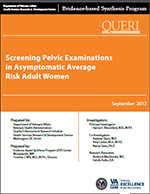
|
Principal Investigator:
Hanna E. Bloomfield, M.D., M.P.H. Evidence-based Synthesis Program (ESP) Center, Minneapolis VA Medical Center,
Minneapolis, MN
Washington (DC): Department of Veterans Affairs; September 2013 |
Download PDF: Complete Report, Executive Summary, Report, Appendices
The routine pelvic examination has been a usual part of preventive care for women for many decades. In 2008, 63.4 million pelvic examinations were performed in the United States. Many women and providers believe that the routine pelvic exam should be included in an annual comprehensive well-woman visit. The exam consists of inspection of the external genitalia, speculum examination of the vagina and cervix, bimanual examination, and sometimes rectal or rectovaginal examination. Traditionally, the examination in the asymptomatic average risk women has been used to screen for pathology through palpation, visualization, and specimen collection.
Pathology potentially detectable on the pelvic examination includes malignancies (e.g., cervical, ovarian, uterine, bladder, vaginal or vulvar); infections (e.g., Chlamydia, gonorrhea, warts, candidiasis, bacterial vaginosis); pelvic inflammatory disease (PID); or other pathology (e.g., atrophic vaginitis, cervical polyps, uterine prolapse, fibroids). In addition, pelvic examinations are often performed prior to the provision of hormonal contraception. Recent high quality evidence-based reviews and guidelines have concluded that pelvic examinations are not required for Chlamydia and gonorrhea screening or for hormonal contraception initiation and up-to-date evidence-based guidelines for cervical cancer screening are also available. However, we are unaware of any systematic reviews that have investigated the utility of the pelvic examination for the other indications.
This systematic review was undertaken to evaluate the benefits and harms of the routine screening pelvic examination in asymptomatic, average risk, non-pregnant, adult women. For cervical cancer and sexually transmitted infection (i.e., Chlamydia and gonorrhea) screening and for initiation of hormonal contraception we summarize the results of recent reviews and guidelines from major US health organizations. For all other indications, we performed and report results from a comprehensive search of the medical literature.
Key questions: